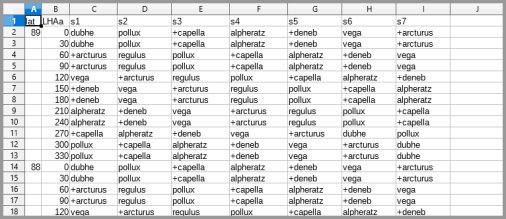
NavList:
A Community Devoted to the Preservation and Practice of Celestial Navigation and Other Methods of Traditional Wayfinding
From: Frank Reed
Date: 2017 Nov 24, 12:08 -0800
Stan, you wrote:
"When these tables were originally created, perhaps the selections were made by human "computers", doing it in much the same way I did. Must have been painful!"
Not painful. And not necessarily difficult. One person working steadily could have the job done in two weeks, at most. Maybe it sounds painful to you because you're thinking of it as a computing task where someone has to sit down and do calculations. But that would be the worst way to do it. Just get out your favorite analog computer for this task. Oh, and I don't mean a Rude star finder... I mean a planetarium. Without a doubt, the folks in the US military back then could easily borrow a commercial planetarium for a week or maybe they used one of their own. Then you just do the usual "nested for loop": hit every 15° of LHA Aries from 0°-345° and visit every 10° of latitude from 50°N to 50°S and then every 30° of LHA Aries for 60° and 70° N/S and finally every 90° of LHA Aries at 80° N/S. That gives 320 unique cases to examine. At most, you would need five minutes per case, including a little fiddling to decide the best latitude to switch from one set of stars to the next. That's less than 30 hours of work --an easy week. Another week to double-check everything, and you're done. And the nice thing is you're done for all time. The selected stars are good for centuries. Bear in mind that these lists are not perfect. They can't be. And they don't have to be...
By the way, Dave Walden also tried to work out the algorithm for star selection some years ago. I assume when he's done eating leftover turkey he'll post his results. If I remember correctly, he reached conclusions similar to yours: there is evidence of a simple algorithm but also evidence of manual editing of the lists and some degree of arbitrariness.
Suppose you want to duplicate this today with a computer algorithm. How should you go about it? That depends on your purpose. If your goal is to match the published tables, then you just take any government-issue PDF of volume 1 and strip it down until you have nothing but the tables of star names for each LHA Aries and Latitude pair. Treat those as a fixed list. And that's completely legitimate. But if your goal is to produce something for real modern celestial navigation, you could generate your own lists of stars that are perhaps more logical and not constrained by the prejudices of a system created seventy freaking years ago. For example, a modern navigator should feel much more comfortable using stars as low as 1.5° altitude and above 75° in some cases. Also high arctic latitudes could be dropped. And Polaris could be included as a normal star, as Greg Rudzinski has already suggested.
Since I have done the first case, stripping down the g.i. PDF as described above, I'm attaching a csv/txt file for every line of Pub249 vol.1. Although this appears to be over 3800 cases, there are only a few hundred unique selections. Each line gives the latitude (if blank, use the lat from a line above), then LHA Aries for the start of the band, then a list of seven stars. Among the stars, the recommended stars for a three-body fix are indicated with a leading '+'. This list can easily serve as the basis for a "roll-your-own" edition of Pub.249 vol.1.
Frank Reed







